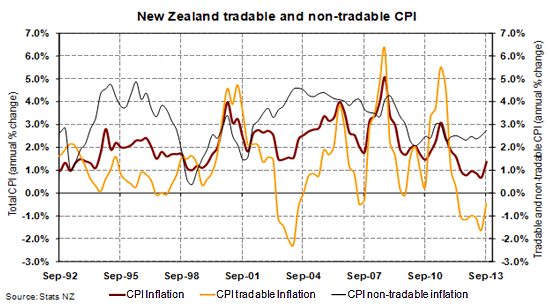
 By Roger J Kerr
By Roger J Kerr
Borrowers and investors who are at risk to market interest rate movements are advised to examine the chart below very carefully to work out where NZ short-term interest rate might be headed in 2014.
What the chart tells us is the value of the NZ dollar plays a dominant part in determining overall level of inflation in our economy.
Prices for imported consumer goods reduce as the NZD value against the USD increases.
Tradable inflation (imported product) has been negative over recent years which has pulled the overall inflation rate lower to 1.00% in 2012 and 2013.
Non-tradable inflation (i.e. domestic prices such as electricity, rates, house maintenance and insurance premiums) remains stubbornly high at a an annual rate close to 3.00%, partly due to a lack of real competition in some parts of the economy.
The high NZ dollar has disguised continuing inflationary pressures in the domestic economy.
These will be exposed if and when the NZ dollar depreciates and tradable inflation increases.
Note how the overall inflation breached the RBNZ cap at 3.0% in 2006 when the NZ dollar depreciated in 2005 and tradable inflation shot up.
A stronger USD on the world stage and a weaker Australian dollar in the post mining boom era both point to a lower NZD/USD exchange rate in 2014.
Governor Wheeler will be very conscious of the 2005/2006 history repeating itself and inflation getting away on him.
The take-out from this analysis is that short-term interest rates will be increasing sooner and in larger jumps in 2014 if the NZ dollar depreciates into the mid-0.7000’s.
Should the NZD/USD exchange rate remain well above 0.8000, the RBNZ will delay OCR increases and the interest rate market will lower the current 3.70% pricing on two-year swap rates.
The Governor’s problem is that global currency movements are way beyond his control and influence, yet he has to set domestic monetary conditions based on accurately forecasting what the NZD/USD rate will do.

-----------------------------------------------------------
To subscribe to our daily Currency Rate Sheet email, enter your email address here.
No chart with that title exists.
Roger J Kerr is a partner at PwC. He specialises in fixed interest securities and is a commentator on economics and markets. More commentary and useful information on fixed interest investing can be found at rogeradvice.com
3 Comments
Maybe the RBNZ Governor should check out the flows of significant world players as a reference to guide his decision making.
Led by Mizuho Asset Management Co., at least five money managers that oversee a combined $236 billion are snapping up Treasuries due in about a decade as inflation-adjusted yields approach the highest level since 1998 relative to Japanese government bonds. Japan’s holdings of U.S. debt rose by $98.2 billion last quarter, the second-largest increase since the Treasury Department began releasing the data in 2000.
While Pacific Investment Management Co.’s Bill Gross is recommending short-term U.S. debt, Japanese bond investors are finding value in longer-dated Treasuries as U.S. consumer prices rise the least since 2009. Prime Minister Shinzo Abe’s stimulus policies are also weakening the yen by the most in three decades this year, bolstering the allure of dollar-based assets.
“There’s tremendous deflationary pressure in the U.S.,” Yusuke Ito, a senior fund manager at Mizuho Asset, which oversees about $32 billion, said in a telephone interview from Tokyo on Dec. 4. “For bonds, the longer the maturity, the better” as slowing inflation preserves the purchasing power of fixed-rate interest payments.
Ito said the firm held most of its U.S. debt in Treasuries due in five years and more and predicts yields on the 10-year notes will fall to 2.1 percent by the middle of 2014 from 2.86 percent last week. Mizuho Asset’s holdings also had a longer average maturity than those in the benchmark index it uses to gauge performance, he said. Read more
Stephen,I would actually like to see some tapering now just to see the markets react. There's been so much debate for so long. Time to see if the US economy is up to it or not.
wrong

We welcome your comments below. If you are not already registered, please register to comment.
Remember we welcome robust, respectful and insightful debate. We don't welcome abusive or defamatory comments and will de-register those repeatedly making such comments. Our current comment policy is here.